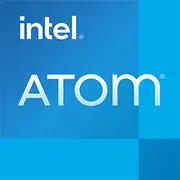Intel Atom Z3770

Intel Atom Z3770: Review and Relevance in 2025
Low Power Consumption vs. Limited Performance
Introduction
The Intel Atom Z3770 processor, released in 2013, was part of the Bay Trail-T platform aimed at mobile devices. Despite its age, devices featuring this chip can still be found in the budget segment in 2025. Let’s explore who might find it useful today and what compromises it entails.
Architecture and Process Technology
22nm and Silvermont Cores
The Atom Z3770 is built on a 22nm process technology, which has become outdated by 2025. Its 4 cores (without Hyper-Threading) are based on the Silvermont microarchitecture, designed to balance performance and energy efficiency.
- Clock Speeds: 1.46 GHz (base), up to 2.39 GHz in Turbo Boost mode.
- Graphics: Integrated HD Graphics (Bay Trail) with 4 execution units (EU) and up to 667 MHz.
Architecture Features:
- Lack of AVX instruction support, limiting compatibility with modern software.
- 2 MB of L2 cache shared between cores.
- Support for DDR3L-1066/1333 MHz (up to 4 GB of RAM).
Power Consumption and TDP
8W: Energy for Portability
A TDP of 8W allows for passive cooling, making devices with the Z3770 silent and slim. However, by 2025, even budget chips (like the Intel N100) with a TDP of 6W offer twice the performance.
Practical Implications:
- Low heat output makes it ideal for tablets and mini-PCs.
- Limited performance under peak loads due to a "ceiling" on power consumption.
Performance
Office, Multimedia, and Gaming: What’s Possible?
Office Tasks:
- Browsing with 5-10 tabs and using office applications (LibreOffice, Google Docs) is feasible but may experience delays with multitasking.
- Video calls: maximum HD 720p, as the lack of hardware acceleration for AV1/VP9 places the burden on the CPU.
Multimedia:
- Full HD video playback is possible thanks to H.264 decoding. 4K and HDR are not supported.
- Editing in Shotcut or DaVinci Resolve: only simple projects with low resolution are feasible.
Gaming:
- Integrated graphics handle games released up to 2015 at low settings:
- CS:GO — 20-25 FPS at 720p.
- Minecraft — 30 FPS with minimum graphics settings.
- Turbo mode briefly boosts CPU speed, but any gains in gaming are negligible due to the weak GPU.
Use Cases
Who is the Z3770 Suitable for in 2025?
1. Devices for Basic Tasks:
- Reading, web surfing, YouTube.
- Children’s laptops or tablets (e.g., Dell Venue 11 Pro).
2. Remote Office Work:
- Only if work is limited to cloud services and text editors.
3. Compact Systems:
- Mini-PCs for digital signage or terminals.
Who it’s Not Suitable For:
- Gamers, designers, video editors.
Battery Life
How Does an 8W TDP Affect Battery Life?
Devices with the Z3770 (e.g., ASUS Transformer Book T100) offered 8-11 hours of operation in 2014. By 2025, batteries may degrade, but new equivalents (with a capacity of 30-40 Wh) can last 6-7 hours under:
- 50% brightness.
- Power-saving mode.
Power-Saving Technologies:
- Intel SpeedStep — dynamic frequency adjustment.
- C-States — turning off unused cores.
Tip: Disable background applications and utilize lightweight operating systems (like Chrome OS Flex or Linux Lite) to extend battery life.
Comparison with Competitors
Atom Z3770 vs. Modern Alternatives
1. Intel N100 (2023):
- 6W TDP, 4 Gracemont cores, Intel UHD graphics (24 EU).
- Performance 2-3 times higher.
- Devices starting from $250 (e.g., Chuwi LarkBox X).
2. AMD Athlon Silver 7120U (2024):
- 15W TDP, 2 Zen 2 cores, Radeon 610M graphics.
- Better for multi-threaded tasks, but requires active cooling.
3. Apple A14 Bionic (2020):
- 6W TDP, 6 cores, 4-core graphics.
- 3-4 times faster in single-threaded tasks.
Conclusion: The Z3770 falls behind even budget models of 2025, but is low-cost to produce.
Pros and Cons
Strengths:
- Ultra-low power consumption.
- Silent operation (passive cooling).
- Compatibility with Windows 10/11 and Linux.
Weaknesses:
- Does not support modern codecs (AV1, VP9).
- Maximum of 4 GB of RAM — limiting multitasking.
- No USB 3.2 or Wi-Fi 6 support.
Device Selection Recommendations
What to Look for in 2025?
1. Type of Device:
- 2-in-1 Tablets (e.g., Lenovo Miix 320) — for mobility.
- Mini-PCs — as a media center for TV.
2. Specifications:
- SSD instead of eMMC — speeds up system performance.
- IPS Screen — for comfortable reading.
3. Price: New devices featuring the Z3770 in 2025 will be rare, but if you find one, don’t overpay. A reasonable price is $150-200.
Tip: Consider alternatives — used laptops with Intel Core i3 of the 8th generation ($200-250) will be more powerful.
Final Conclusion
The Intel Atom Z3770 in 2025 is a choice for specific scenarios:
- Budget Devices: When price takes precedence over performance.
- Specialized Equipment: Terminals, information panels.
- Backup Device: For trips where the risk of damage is high.
Key Benefits: portability, compactness, quiet operation. However, for most users, modern processors with a better balance of power and efficiency are preferable.
If you are looking for a device "for an hour a day" for emails and documents — the Z3770 can still serve. But by 2025, even $300 opens access to much faster and more modern solutions.
Basic
CPU Specifications
Memory Specifications
GPU Specifications
Benchmarks
Compared to Other CPU
Share in social media
Or Link To Us
<a href="https://cputronic.com/en/cpu/intel-atom-z3770" target="_blank">Intel Atom Z3770</a>